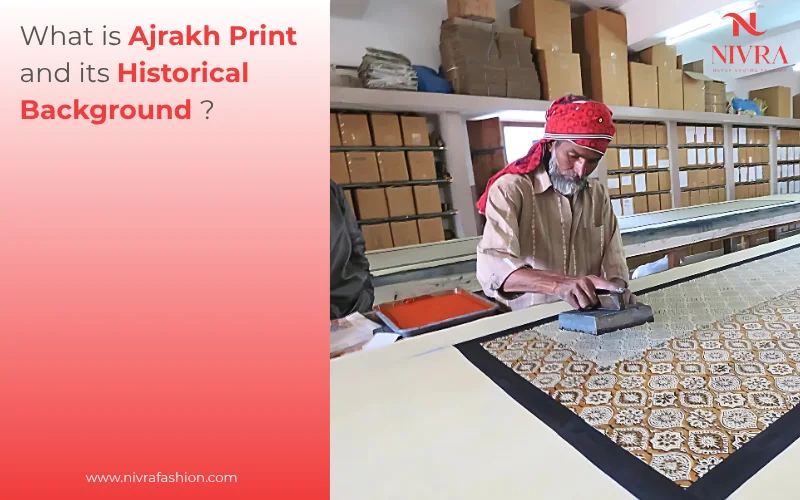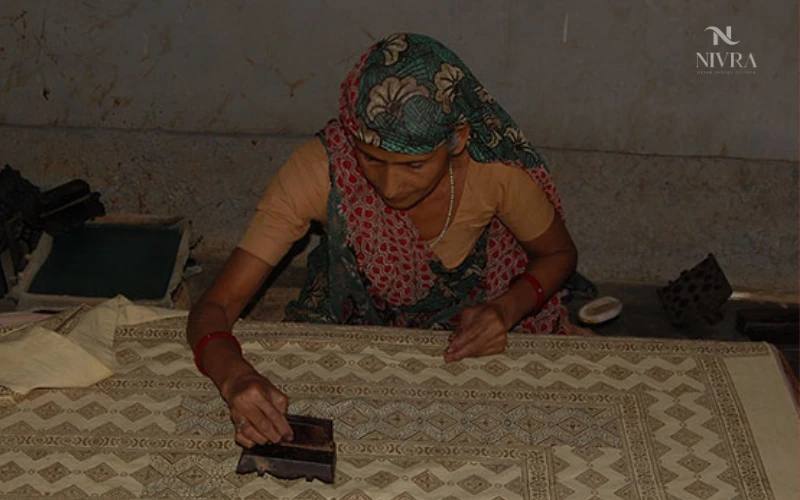Ajrakh is a block printing textile art that holds significant cultural importance. They are believed to have originated mainly in the Indian regions of Gujarat and Rajasthan, as well as Sindh in Pakistan. This craft, which is traditionally practised by the Muslim artisan communities, is a detailed and time-consuming process.
It uses hand-carved wooden blocks and natural dyes to create stunning patterns. The fabric undergoes many steps of printing and dyeing to produce rich, colourful, and symmetrical designs. More than just being a fabric, Ajrakh is a true reflection of history, identity, and craftsmanship that dates back over 4,000 years. Continue reading this article to learn what is Ajrakh print, including its history, unique techniques, and interesting facts.
History of Ajrakh Print
The word “Ajrakh” is believed to be derived from the Arabic word “Azrak,” which means “blue”, a colour that is often seen in Ajrakh prints. Some also say the name comes from two Hindi words, “Aaj” and “Rakh” , meaning “Keep it today.”
Archaeological excavations at Indus Valley Civilization sites suggest that block printing on cotton with geometric patterns might be one of the oldest forms of textile printing in the Indian subcontinent. Historical records also show that a lot of indigo-dyed cotton fabric was made in the Indus region and sent by sea to places like Egypt, Babylon, and the Persian Gulf.
In ancient Egypt, this deep blue cloth was even used to wrap mummies for burial. Similar printed fabrics with geometric designs found in the Kutch region have also been found in old port areas near the Red Sea, such as Fustat, near Cairo.
Ajrakh Print and Dyes
One of the distinguishing features of Ajrakh prints is the use of natural dyes in the fabric. Ajrakh printing traditionally features a palette of primary colours, such as blue, red, black, yellow, green and white. These shades are derived from natural dyes, which include indigo, lokhand (iron), harde, fatakdi(alum), tamarind, maati (clay),gud (jaggery), Baval nu gond (Gum),haldi (turmeric), dried pomegranate peels (dadam), majith(madder root) and rhubarb.
Motifs in Ajrakh Print
The designs in the Ajrakh print closely resemble the culture and history of the region where it originated. These designs use geometric shapes and include patterns inspired by nature, such as flowers, birds, and animals.
Besides looking beautiful, these patterns also convey special meanings. They often represent local traditions, spiritual beliefs, and cultural values, making each Ajrakh print a true reflection of the community’s identity and heritage.
Ajrakh Printing Process
Here are some of the 14 different stages involved in the making of Ajrakh prints:
1. Grey Cloth
The cotton fabric in its raw, unprocessed state is known as grey cloth. This material contains a variety of impurities, including natural substances like oils, waxes, and pectin, as well as additional lubricants introduced during the spinning and weaving stages to ease the manufacturing process and minimize thread breakage.
This gives the fabric a dull, slightly yellowish appearance, which is why the fabric in the initial stage is referred to as “grey” cloth. Since these residues significantly reduce the fabric’s ability to absorb dyes or prints, they must be carefully eliminated through pre-treatment before further processing.
2. Saaj
In this step, the cloth is repeatedly soaked in a solution called Neerani, a traditional mixture of castor oil, soda ash, and camel dung. After soaking, the fabric is left to dry under the sun. This cycle of soaking and drying is performed multiple times until the cotton achieves a clean, bright white tone, making it ready for the next steps in the printing process.
3. Washing
After the Saaj treatment, the fabric is left with a heavy layer of foam and residue. To eliminate these residues, the cloth is thoroughly rinsed with clean water so that all traces of the lather are completely removed before proceeding to the next stage.
4. Kasano
In this stage, the fabric is treated with a paste made from Harde, a yellow-toned natural substance rich in tannic acid. The powdered Harde is blended into a thick paste and carefully applied to the cloth so that it penetrates evenly across the entire surface of the fibres. Compared to earlier steps, the fabric is not washed after this treatment. Instead, the fabric is left to dry under the sun while the paste remains applied. This process helps prepare the fabric to absorb better and bind the mordants used in later printing stages.
5. Khariyanu
In this step, the design outlines meant to remain white are carefully stamped onto the fabric using hand-carved wooden blocks. A resist paste made from a blend of lime and natural tree gum is applied during printing. This paste prevents dye from penetrating those specific areas, preserving the white portions of the pattern during subsequent dyeing processes.
6. Kut
A special paste called Kut is used to create black portions in the design. This paste is prepared by fermenting jaggery with iron scraps for around 15 days. Once fermentation is complete, the liquid is strained and blended with a gum-based paste. When the Kut is applied to the fabric, the paste reacts with the tannic acid used in the earlier Kasano treatment, resulting in a rich, chocolate-black hue in the printed areas.
7. Pa Mordant
This step involves preparing a paste known as Pa to achieve the red tones in the design. This paste is prepared by combining alum with a thick, sticky base made from boiled and ground-roasted tamarind seeds. This mixture serves as a mordant, which helps the fabric to absorb red dye in the desired areas. The paste is applied using carved wooden blocks, which are designed in such a way that only the raised surfaces transfer the paste onto specific sections of the cloth, referred to as Mavi.
8. Gach Resist
At this stage, a smooth paste called Gach is used. It is made by blending tree gum, water, clay, millet flour, and alum into a fine mixture. This paste is carefully printed over the previously applied Pa areas to intensify the red shades. Also, the mixture of clay and millet flour acts as a resist that prevents the indigo dye from spreading into the areas where the paste is applied.
9. Dhori Gach Resist
Dhori Gach is a variation of the previous Gach step that excludes alum composition from the paste. This paste is applied to the remaining white, black, and Pa-printed sections that were not covered by the earlier Gach application. The clay and millet flour in the paste serve as resist agents, protecting these areas from absorbing indigo dye during later stages. To keep the resist intact and prevent it from smearing, artisans immediately dust the freshly applied paste with powdered cow dung to help fix the design in place.
10. Indigo Dip
To achieve the signature blue hue, the fabric is dipped in a vat containing natural indigo dye. When first removed from the vat, the cloth appears greenish, but as it comes into contact with air, the oxygen triggers a chemical reaction that transforms the colour into a deep blue. For a richer, more intense shade, the fabric is often dipped in indigo dye multiple times, which helps get a deeper tone with each round.
11. Washing
After dyeing, the fabric is thoroughly washed to remove any remaining resist paste and to rinse off excess indigo particles. This step clearly reveals the design and sets the colours properly.
12. Red Dyeing
To produce a vibrant red shade, artisans gently heat Alizarin crystals or Indian madder roots in a copper vessel over a slow flame. The fabric is then immersed in this dye bath and stirred steadily using two wooden sticks, allowing the colour to develop evenly. This process, which typically lasts between 2 to 4 hours, binds the dye thoroughly to the mordanted areas of the cloth.
13. Tapano
During this stage, any white sections of the fabric that have taken on a pinkish colour from the earlier dyeing stages are restored to their original brightness. For this, the artisans soak the cloth in a solution made from camel dung, which is then spread out to dry in the sun near a sandy riverbank. Depending on the weather conditions and the intensity of the sunlight, it may take as long as 3 days to finish the tapano process.
14. Final Touch
In this last stage, the fabric undergoes a complete wash to eliminate any leftover dyes. A mixture of water, alum, and tin is used during this stage, which helps brighten the colours and give the fabric a refined, polished appearance, ensuring it’s ready for use or sale.
Wrapping Up
For those who are unaware of what is Ajrakh print, it is a traditional textile art that traces its origins to the rich cultural heritage of India, particularly within the artisan communities of Gujarat, Rajasthan, and Sindh. Ajrakh print is widely known for its symmetrical patterns, vibrant natural dyes, and multi-step printing process that requires both skill and dedication.
Even though we live in a fast-paced world of constantly evolving fashion and synthetic materials, Ajrakh remains a timeless example of sustainable, handcrafted artistry.
Frequently Asked Questions on Ajrakh Print
What is Ajrakh print?
Ajrakh is an age-old Indian block printing art known for its detailed geometric designs and symbolic motifs. It is crafted with natural dyes and printed by hand using intricately carved wooden blocks.
Where is Ajrakh printing practised?
Ajrakh printing is primarily carried out in the Kutch region of Gujarat, especially in the village of Ajrakhpur. This traditional craft also holds deep roots in Pakistan’s Sindh province, where it remains widely practised.
How can we identify Ajrakh?
Ajrakh stands out for its distinctive block printing style, featuring striking floral or geometric motifs. It is crafted using natural dyes such as deep indigo and rich red tones.
What is the meaning of Ajrakh print?
The term “Ajrakh” is thought to originate either from the Arabic word “azrak,” which translates to “blue,” or from the Hindi expression “aaj rakh,” meaning “keep it today.”
What is special about Ajrak?
Ajrakh is a distinctive form of Indian textile art widely recognised for its detailed block-printed motifs and the use of natural dyes. Ajrakh printing is a labor-intensive process that includes several stages of printing. Ajrakh is known for its vivid hues and symmetrical floral and geometric patterns that involve exceptional artisanal skill.













